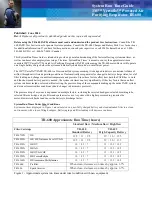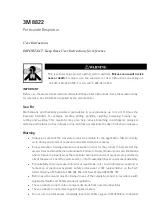
USER’S INSTRUCTIONS
IST-USO-0905109
Rev. N. 03 dtd 09/03/2018
IDP109
Page 1 of 2
K80E - AL1N
SUPPLIED AIR RESPIRATOR
TYPE C CONTINUOUS FLOW CLASS
Approved Respirator configuration:
Part number
Helmet
Air control
unit
Breathing
tube
Air supply
hose
Belt
Noise
reducer
Airflow
indicator
NIOSH APPROVAL
0313190
K80E
0302021
AL1
0303067
0309116
0309117
0307020
1614003
0806026
TC-19C-317
1. DESCRIPTION
1.1 K80E HELMET (0302021): It is composed of: a fiberglass shell
covered with 3 coats of paint, the last one of which, the most external
one, is polyurethane; a polycarbonate visor; a polyamide collar which
closes efficiently and comfortably round the wearer’s neck; a head-
band adjustable from 53 to 63 cm (6-5/8 to 7-7/8 hat size).
1.2 AL1 AIR CONTROL UNIT (0303067): It is composed of a
diaphragm pressure regulator and connects the air supply hose to the
breathing tube attached to the helmet.
1.3 BREATHING TUBE (0309116): It is composed of a rubber hose
with couplings for connection to the K80E helmet.
1.4 NOISE REDUCER (1614003): It is composed of various layers of
synthetic felt in a copper housing.
1.5 COMPRESSED AIR SUPPLY HOSE (0309117) It is composed of
a 25 feet long rubber hose with quick disconnect and adaptor
couplings. Up to six 25ft. hose segments may be connected to each
other to form an air-line which is max. 150ft. long. The air supply hose
connects the breathing tube to an air source supplying clean
breathable air.
1.6 AIRFLOW INDICATOR (0806026): composed of a transparent
tube with indicator ball inside. To check the airflow performance of the
respirator it is supplied with, before each use.
2. TECHNICAL CHARACTERISTICS
2.1 K80E HELMET:
Shell : Fiberglass - Face shield : Polycarbonate – Head suspension:
Polyethylene – Face shield gasket: polyethylene foam.
2.2 AL1 air control unit:
Inlet pressure; minimum 70 psi (4,9 Bar)
maximum 105 psi (7,4 Bar)
Airflow: > 200 Lpm (in the inlet pressure range)
Noise level with hose and noise reducer; < 80 Db
3. OPERATION
3.1 The air control unit , supplied with breathable compressed air,
provides an airflow to the inside of the helmet. The helmet goes into
slight overpressure and the wearer breathes clean air. Expired air is
expelled through the diaphragm valves.
4. USE
4.1 For the protection of the eyes, head and respiratory system of the
wearer. These respirators can be worn for general purpose
applications , including pharmaceutical manufacturing, chemical and
pesticide handling, tank cleaning, spray painting and other industrial
and agricultural applications in which hazardous compounds are
present.
4.2
LIMITATIONS/CAUTIONS
a) These respirators are not approved for use in any atmosphere
immediately dangerous to life or health (IDLH).
b) Do not exceed maximum use concentrations established by
regulatory standards.
c) These respirators can be used only when provided with breathable
air meeting the requirements for Type 1 gaseous air described in the
ANSI/compressed Gas Association Commodity Specification G-7.1
Grade D or higher quality as specified in Federal regulations 42 CFR,
Part 84.141 (b).
d) Use only the pressure ranges and hose lengths specified in these
instructions.
e) Failure to properly use this product may result in injury or death.
f) All approved respirators shall be selected, fitted, used and
maintained in accordance with MSHA, OSHA, and other applicable
regulations.
g) Never substitute, modify, add, or omit parts. Use only the
replacement parts listed in the configuration specified by the
manufacturer.
5. USE INSTRUCTIONS
5.1 HELMET SET-UP:
Remove protective film from visor. The film was applied to
preserve the transparency of the polycarbonate until the moment
of use.
Position the noise reducer inside the helmet inlet connection.
Fit the helmet on head steadily and adjust head band fit.
Take helmet off and connect breathing tube (P/N 0309116), with
the AL1 air control unit already attached, to the helmet by pushing
tube coupling into helmet connection and turning the coupling
clockwise.
5.2 RESPIRATOR SET UP
Connect air outlet end of air supply hose (P/N 0309117) to AL1
air control unit.
Connect other end of air supply hose to at least 15 cfm of
compressed air as per Gas Association Commodity Specification
G-7.1 Grade D or higher breathable air.
5.3 WEARING INSTRUCTIONS:
DON HELMET IN FRESH AIR ONLY
- Buckle belt, with air control unit already fitted, around waist.
- Don helmet and tighten collar drawstring firmly around neck by
pushing on button and sliding up. The drawstring should be pulled as
close as possible round neck to assure maximum closure but it should
at all times feel comfortable and not restrict breathing in any way.
5.4 AIR FLOW INDICATOR – INSTRUCTIONS AND PERFORMANCE
CHECK
Carry out the airflow performance check hereunder before each
respirator use:
Remove helmet connection breathing tube.
Insert noise reducer in the bottom side of the flow indicator.
Insert airflow indicator onto the breathing tube and position so
that the indicator is upright.
Observe the position of the indicator ball inside the tube:
o
If the indicator ball rises above the indicator line (6
cfm/170 l.p.m: this is the minimum flow required), the
respirator is ready for use.
o
If the ball fails to move or remains on or below the
indicator line, insufficient airflow is being provided. This
may be the result of a low pressure of the compressed
air line or a overloaded noise reducer or a damaged
breathing tube or air control unit. Check the
















